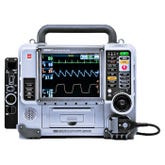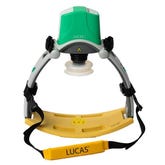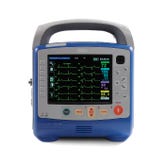A Brief Explanation of What a Defibrillator Really Does
- Mar 26, 2018

Defibrillators can both monitor and regulate heartbeats.
The heart uses electrical impulses to contract the muscles surrounding the organ to pump oxygenated blood to other tissues. The heart does this by polarizing its pacemaker. The depolarization is what makes the heart contract and produces the PQRST (Figure 1) wave form that can be read on an electrocardiogram (ECG) machine. The ECG actually measures the electrical impulse and not the physical contraction of the heart.

There are a multitude of reasons that a heart could need a defibrillator. The most common reason (and what the defibrillator is named for), is the ventricular fibrillation. This is where the normal heart rhythm is changed into very short and frequent pulses (Figure 2). These are so short that no actual blood is leaving the ventricles and is not circulating within the body. This could cause the victim to suffocate on a cellular scale if not treated immediately.

Another common form of cardiac distress that can be corrected by a defibrillator is ventricular tachycardia (Figure 3). Essentially, this is where the heartbeat is very increased with a wide QRS wave.

The defibrillator works by depolarizing the whole heart system. This will give a “fresh start” to the heart to repolarize and return to normal electrical activity. If the shock is not strong enough, the heart might not completely repolarize, leading to a continuation of arrhythmia. Defibrillators will then monitor the new heartbeat either advising you to shock again or to make sure the patient does not slip back into arrhythmia.
A common misconception is that defibrillators will restart a heart that is in asystole (“flat lining”) (Figure 4). This is incorrect. Once the heart is unable to create its own electrical pulse, a defibrillator will not work.

Sources:
Cyberphysics. (2013). The PQRST Heart Trace. Retrieved from Cyberphysics.co.uk: http://www.cyberphysics.co.uk/topics/medical/heart/PQRST.html
HeartSite. (2013, December 18). Heart Electrical Activity. Retrieved from HeartSite.com: http://www.heartsite.com/html/electrical_activity.html
Mauvila. (2004). Heart Muscle. Retrieved from Mauvila: http://www.mauvila.com/ECG/ecg_conduction.htm
Medical Training and Simulation. (2014). Asystole. Retrieved from Practical Clinical Skills: http://www.practicalclinicalskills.com/ekg/Asystole
Medical Training and Simulation LLC. (2014). Ventricular Fibrillation. Retrieved from Practical Clinical Skills: http://www.practicalclinicalskills.com/ekg/Ventricular-Fibrillation
Medical Training and Simulation LLC. (2014). Ventricular Tachycardia. Retrieved from Practical Clinical Skills: http://www.practicalclinicalskills.com/ekg/Ventricular-Tachycardia
ScienceDaily. (2014). Defibrillation. Retrieved from ScienceDaily: http://www.sciencedaily.com/articles/d/defibrillation.htm
Image Credit:
Figure 1: Cyberphysics. (2013). The PQRST Heart Trace. Retrieved from Cyberphysics.co.uk: http://www.cyberphysics.co.uk/topics/medical/heart/PQRST.html
Figure 2: Medical Training and Simulation LLC. (2014). Ventricular Fibrillation. Retrieved from Practical Clinical Skills: http://www.practicalclinicalskills.com/ekg/Ventricular-Fibrillation
Figure 3: Medical Training and Simulation LLC. (2014). Ventricular Tachycardia. Retrieved from Practical Clinical Skills: http://www.practicalclinicalskills.com/ekg/Ventricular-Tachycardia
Figure 4: Medical Training and Simulation. (2014). Asystole. Retrieved from Practical Clinical Skills: http://www.practicalclinicalskills.com/ekg/Asystole








 CALL US:
CALL US: